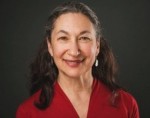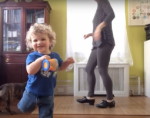
Framed: Six Glimpses of the Body in Motion
by Lynn Matluck Brooks
As performances, classes, meetings, libraries, and more pour forth notices of digital offerings to a world under virus lockdown, my eyes have grown weary of announcements streaming across my computer screen. The overwhelming number of opportunities that I can access for archived or livestreamed events incites my feelings of duty-bound acceptance, or guilt at what I’m passing up, or fatigue. Fortunately, a sepia-toned image in one such email from the Library Company of Philadelphia (LCP) caught my eyes before they glazed over. It was a shot from the Thomas Eakins' Motion Studies Photographs described, in part, on the LCP website as a “Series of six nude motion studies photographed by Thomas Eakins at the University of Pennsylvania.” Shot in 1884-1885—long, long before the COVID-19 pandemic, and even long before the 1918 Spanish flu epidemic hit Philly hard—these images allowed me to dive briefly into other times and other subjects. And, they are beautiful. Come, dive in with me.
Known primarily for his paintings, many of which featured nude figures in repose and action, Philadelphian Eakins worked at Penn with English motion-photographer Eadweard Muybridge, whose studies in this field are far more extensive and renowned than are those by Eakins. No doubt, however, this work richly supplemented Eakins’ dedicated practice of drawing from the live nude model, as the time-capture photographs allowed him to break down the body’s movement capacities minutely. From this time onward, Eakins’ paintings regularly featured female and, particularly, male nudes, the latter often in action.
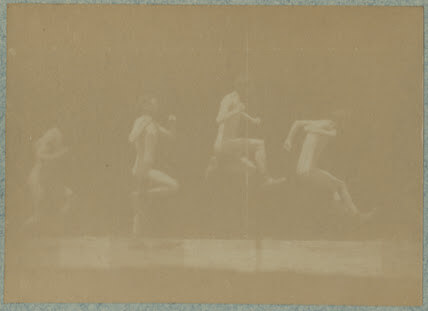
Photo: Thomas Eakins, image 1, Library Company of Philadelphia
In the 6-image set, numbers 1, 2, 5, and 6 show a male figure jumping. One and 2 are the same kind of jump—taking off from one leg and landing on both feet—but clearly different takes, as limb angles, number of captured positions, and camera proximity differ slightly. Five and 6 both capture true jumps—two feet to two feet—but again, different in noticeable details. The center images, 3 and 4, feature strides—3 a kind of jog moving across the frame from left to right, and 4 apparently a determined walk right to left, a direction of motion unique among these six.
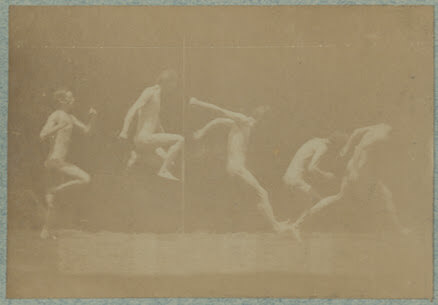
Photo: Thomas Eakins, image 2, Library Company of Philadelphia
In 1 and 2, I am drawn to the figure’s sharp angularity of pelvis, thigh, and lower leg, folding inward, along with the arms, to clear the ground in an airborne thrust and gathering toward center against the press of gravity. Then, the limbs explode outward, legs thrusting forward and down, arms flung behind, before the torso plunges into forward space again, arcing over the body’s center line to maintain momentum in the direction of movement.
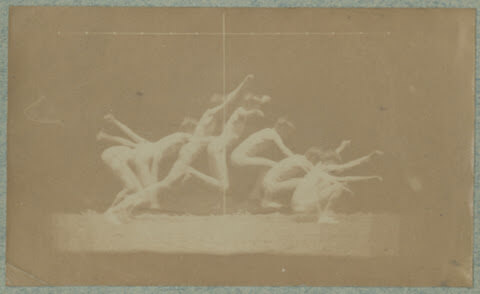
Photo: Thomas Eakins, image 5, Library Company of Philadelphia
Five and 6 (see photo at the head of this article) heighten these same factors of gathering inward, unfolding outward—the flexing now tighter, the stretching longer and even briefly tilting the body into a precarious forward angle of space-hungry ambition to cover the most ground the jump can skim across. Image 6 shows two immediately sequential jumps: push off, stretch, fold and press forward, land only to push right off again into a stretch, flex inward, fold tighter for more lift, thrust the torso-head forward and flex inward and downward to absorb the landing. End of frame. I’m exhausted.
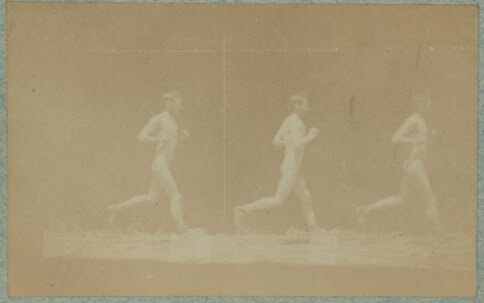
Photo: Thomas Eakins, image 3, Library Company of Philadelphia
I find it recuperative to look at the striding figures in 3 and 4, with their regular rhythms of oppositional arms and legs, alternate weight-bearing, arms and upper back swinging slightly right and left to counterbalance the leg actions. The jogger in 3 balances his head easily above shoulders and flexed arms, the hands lightly clenched. Four, on the other hand—the odd man who moves right to left—projects his head forward, announcing intention, flinging stretched limbs forward and back, going and going and heading right (if leftward) out of the frame.
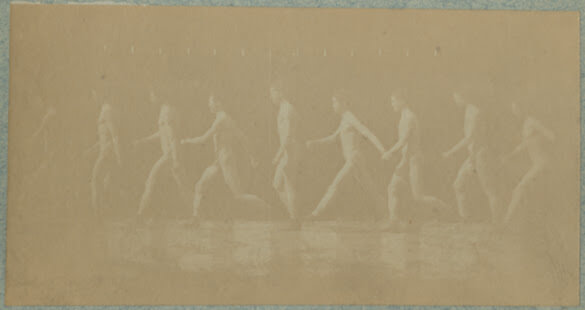
Photo: Thomas Eakins, image 4, Library Company of Philadelphia
Where the movers come from, or go upon exiting the frame, what space they are in—all this the photos leave unrevealed. The floor—the ground, as I read it—seems dirt-like, uneven, dusty. But that might be an artifact of the stop-time photography. Clearly, the images are not about the “where” of the action, but about action itself, suspended in a space that could be anywhere, or nowhere in particular. Yet the figures captured in this suspended world are viscerally real: lithe, lean, reveling in movement, hungry for space upward and, especially, forward. Though the images at LCP blur into faded beige and brown, I can feel the salty, sweaty pleasure of each model’s motion mastery. I want to jump out, and up, and stride forward with their confidence and coordinated effort.
But I am also in a frame, created by time, my time, this time. Not jumping, not striding, I instead cautiously navigate my way through these pandemic days of social distancing, folding into my own world. Though my space is limited, these images give me a chance, now, to reach across time to meet fellow movers, to enjoy their freedom.
Why, I ask myself, do I find these motion studies so much more captivating than much of the virtuosic dancing we can tune into on YouTube, Facebook, Instagram, TikTok, and elsewhere? Perhaps the frantic virtuosity and determined showiness of these videos add more stress to my already-stressed psyche. In contrast, the photographic studies’ revelation of motion broken down into its successive parts that I can contemplate together in one image provides a sense of leisure and timelessness to these fundamental human actions, which gives me a taste of peace, ongoingness, and hope. Perhaps the profile views show a healthy engagement with movement and space for their own sake, utterly apart from confronting an audience with expressive flashes of wow shouting out from the screen’s flatness in so many of the recent videos I have watched.
In any case, I am grateful to Sarah Weatherwax, Emily Smith, and the staff at the Library Company of Philadelphia for the opportunity to study these images closely, for the files they graciously provided for this essay, and for the regular offerings to which LCP is alerting the community as it continues to share resources for entering, understanding, and appreciating Philadelphia’s deep, rich past. I so relished this particular dive.
Thomas Eakins' Motion Studies Photographs, Library Company of Philadelphia, Digital Collection.
By Lynn Matluck Brooks
April 19, 2020


